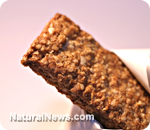Chewy granola bars - A homemade treat to feel good about
(NaturalNews) Granola bars are a convenient on-the-go snack. Unfortunately, typical store-bought varieties are loaded with corn syrup, soybean oil, coloring and flavoring agents and preservatives. If you prefer to eat foods that are grown in nature, rather than created in a lab, try making your own bars with the recipe included here. This recipe is packed with antioxidant-rich ingredients that actually contribute to your health such as cocoa, raw honey, coconut oil and cinnamon. These bars are chewy and delicious, and they are gluten-free and dairy-free, as well. They are perfect for an after-school snack, a lunchbox treat or your other on-the-go needs.

INGREDIENTS:
4 cups old fashioned oats (gluten-free if you prefer)
1/3 cup coconut oil*
1 cup raw honey*
4 teaspoons of pure vanilla extract
1/4 teaspoon of sea salt
1/8 teaspoon of ground cinnamon
1 1/2 cups almonds, chopped (a food processor works great for this)
1/2 cup cocoa nibs* (optional) - These are unsweetened bits of chopped cocoa that contain no sweeteners or other ingredients.
* This ingredient is often not available at regular grocery stores. You may need to shop at a natural health market or online.
DIRECTIONS:
Preheat oven to 350 degrees.
Place oats on an ungreased 11" x 17" rimmed baking sheet and toast in the oven for 10 minutes, stirring every three to four minutes.
Meanwhile, melt honey and oil together in a medium saucepan over medium heat, being careful not to burn it. Remove pan from heat; and add vanilla, salt and cinnamon. Stir until dissolved.
Add toasted oats to the saucepan mixture and toss to coat evenly. Add chopped almonds and stir. Add cocoa nibs (optional) and stir to combine.
Line a smaller (10" x 15") rimmed baking sheet with parchment paper. (Tip: Sprinkle the sheet with a few drops of water first to help keep the paper in place.)
Transfer batter to this cookie sheet and gently spread to all edges. Once entire sheet is covered, press batter firmly into the pan. You can use a large spatula or your hands for this step. To prevent the batter from sticking to your hands, wet your hands or place a sheet of parchment or wax paper between your hands and the batter before pressing.
Bake 8-10 minutes at 350 degrees. The bars are done when they just begin to turn brown at the edges. Don't wait too long or they may burn. Bars will be moist and crumbly when removed from the oven, but they come together as they cool. (It may take a few attempts for you to figure out the best amount of time in your own oven.)
Let bars cool completely (about 90 minutes on a cooling rack; longer if you don't have a cooling rack). Transfer bars and parchment paper to a cutting board and cut into 24 bars.
If you like your bars a little firmer and sweeter, store them in the fridge. They also freeze well for later use; and they can be eaten frozen as well if you forget to thaw them out.
Sources for this article include:
http://www.womenshealthmag.com/nutrition/cinnamon-benefits-explained
http://www.naturalnews.com
http://www.naturalnews.com/036156_Coconut_oil_superfood_healing.html
http://www.globalhealingcenter.com
About the author:
Christy Pooschke is the founder of CompletelyNourished.com - an online community where you can network with others who are interested in natural food, holistic health, green living and positive thinking. The site features hundreds of natural recipes (with photos) for a variety of dietary restrictions (gluten-free, dairy-free, egg-free, vegetarian, soy-free, MSPI, etc.), and more recipes are added weekly. The site also features natural living and inspirational videos, discussion groups and more! Join today! Satisfaction is guaranteed - or your money back!
Christy's passion for natural food and holistic health was sparked in 2007 when she eliminated her Fibromyalgia symptoms through diet and lifestyle changes. Now she is on a mission to help others take control of their own health, as well. Christy is also the author of "Eating Additive-Free" - a natural cookbook and shopping guide. Hard copy and e-book versions are available for purchasehere. If you desire a more individualized approach, Christy also offers long-distance personalized Diet Make-Over consultations to help you reduce your reliance on processed foods in just a few weeks!
Learn more: http://www.naturalnews.com/037101_chewy_granola_bars_recipe_healthy.html#ixzz25qYVrOOs

"Chewy granola bars"
Makes 24 barsINGREDIENTS:
4 cups old fashioned oats (gluten-free if you prefer)
1/3 cup coconut oil*
1 cup raw honey*
4 teaspoons of pure vanilla extract
1/4 teaspoon of sea salt
1/8 teaspoon of ground cinnamon
1 1/2 cups almonds, chopped (a food processor works great for this)
1/2 cup cocoa nibs* (optional) - These are unsweetened bits of chopped cocoa that contain no sweeteners or other ingredients.
* This ingredient is often not available at regular grocery stores. You may need to shop at a natural health market or online.
DIRECTIONS:
Preheat oven to 350 degrees.
Place oats on an ungreased 11" x 17" rimmed baking sheet and toast in the oven for 10 minutes, stirring every three to four minutes.
Meanwhile, melt honey and oil together in a medium saucepan over medium heat, being careful not to burn it. Remove pan from heat; and add vanilla, salt and cinnamon. Stir until dissolved.
Add toasted oats to the saucepan mixture and toss to coat evenly. Add chopped almonds and stir. Add cocoa nibs (optional) and stir to combine.
Line a smaller (10" x 15") rimmed baking sheet with parchment paper. (Tip: Sprinkle the sheet with a few drops of water first to help keep the paper in place.)
Transfer batter to this cookie sheet and gently spread to all edges. Once entire sheet is covered, press batter firmly into the pan. You can use a large spatula or your hands for this step. To prevent the batter from sticking to your hands, wet your hands or place a sheet of parchment or wax paper between your hands and the batter before pressing.
Bake 8-10 minutes at 350 degrees. The bars are done when they just begin to turn brown at the edges. Don't wait too long or they may burn. Bars will be moist and crumbly when removed from the oven, but they come together as they cool. (It may take a few attempts for you to figure out the best amount of time in your own oven.)
Let bars cool completely (about 90 minutes on a cooling rack; longer if you don't have a cooling rack). Transfer bars and parchment paper to a cutting board and cut into 24 bars.
If you like your bars a little firmer and sweeter, store them in the fridge. They also freeze well for later use; and they can be eaten frozen as well if you forget to thaw them out.
Sources for this article include:
http://www.womenshealthmag.com/nutrition/cinnamon-benefits-explained
http://www.naturalnews.com
http://www.naturalnews.com/036156_Coconut_oil_superfood_healing.html
http://www.globalhealingcenter.com
About the author:
Christy Pooschke is the founder of CompletelyNourished.com - an online community where you can network with others who are interested in natural food, holistic health, green living and positive thinking. The site features hundreds of natural recipes (with photos) for a variety of dietary restrictions (gluten-free, dairy-free, egg-free, vegetarian, soy-free, MSPI, etc.), and more recipes are added weekly. The site also features natural living and inspirational videos, discussion groups and more! Join today! Satisfaction is guaranteed - or your money back!
Christy's passion for natural food and holistic health was sparked in 2007 when she eliminated her Fibromyalgia symptoms through diet and lifestyle changes. Now she is on a mission to help others take control of their own health, as well. Christy is also the author of "Eating Additive-Free" - a natural cookbook and shopping guide. Hard copy and e-book versions are available for purchasehere. If you desire a more individualized approach, Christy also offers long-distance personalized Diet Make-Over consultations to help you reduce your reliance on processed foods in just a few weeks!
Learn more: http://www.naturalnews.com/037101_chewy_granola_bars_recipe_healthy.html#ixzz25qYVrOOs

